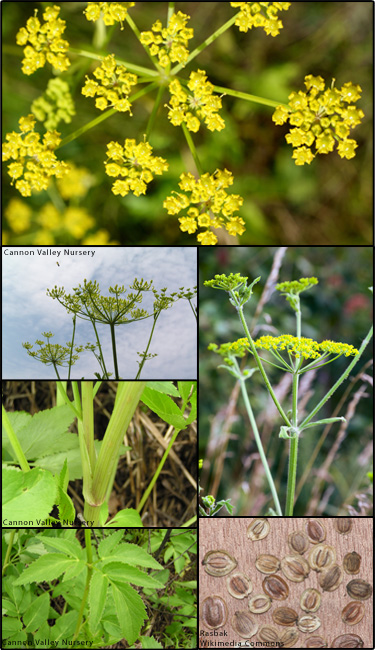Wild parsnip (Pastinaca sativa)
 Synonyms: Pastinaca sativa L. var. pratensis
Synonyms: Pastinaca sativa L. var. pratensisCommon Names: Parsnip
Description: Chemicals found in leaves, stems, and flowers of wild parsnip can cause skin rashes, burns, and blisters, especially in the presence of sunlight; roadside mowing disperses seed.
Habit: Tall, herbaceous biennial, dies after producing seed; up to 1.5 m (5 ft) in height; long, thick taproot.
Leaves: Long (15 cm/6 in) leaves form a basal rosette during first year, mature plants with pinnately compound, alternate leaves of 5-15 oval, smooth, toothed leaflets.
Stems: Upright; unbranched; thick; hairy; grooved.
Flowers: Numerous, small, yellow in color, 5 petals, found in flat, terminal umbels; up to 15 cm (6 in) wide, lateral flowers of umbel often taller than central flowers; bloom June through mid-July.
Fruit and seeds: Seeds are large, flat, round, yellowish; seeds can remain viable for up to four years.
Habitat: Native to Eurasia. Found in open habitats such as prairies, savannas and fens. Tolerates a range of soil and moisture conditions; shade intolerant.
Reproduction: By seed.
Similar species: Native golden alexanders (Zizia aurea) is much shorter than wild parsnip, leaves with 3-7 leaflets; prairie parsnip (Polytaenia nuttallii) has oblong leaflets with few teeth, rounded umbels; cow-parsnip and giant hogweed (Heracleum spp.) have white flowers and leaves that are hairy or pubescent below, rather than smooth.
Monitoring and rapid response: Monitor grassland edges; easiest to identify in June and July when it begins to bloom. Sap causes increased photosensitivity; may cause severe burns, blistering, dermatitis and dark scars, protect skin by using protective clothing and a face shield. Wild parsnip may be cut 5 cm (2 in) below the soil surface if flowering has begun. Remove flower and seed heads from site. Foliar herbicide treatment is effective on basal rosettes. Fire does not control this species but does expose early rosettes in spring for herbicide application in fire adapted communities. Credits: The Michigan Natural Features Inventory (MNFI) has partnered with MISIN to provide the information in this fact sheet. Species images and/or information were used with permission from "A Field Identification Guide to Invasive Plants in Michigan's Natural Communities" and "A Field Guide to Invasive Plants of Aquatic and Wetland Habitats for Michigan.
Common Name: | Wild parsnip |
Scientific Name: | Pastinaca sativa |
Family: | Apiaceae (Carrot) |
Duration: | Biennial |
Habit: | Herbs |
USDA Symbol: | PASA2 |
 View Species Course |
|
